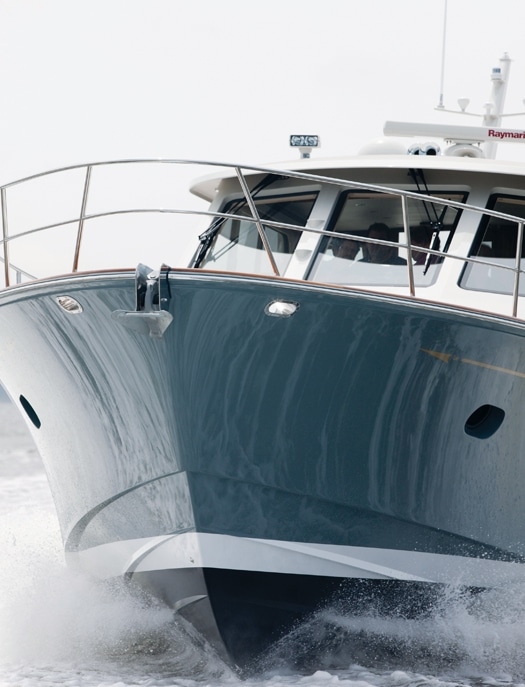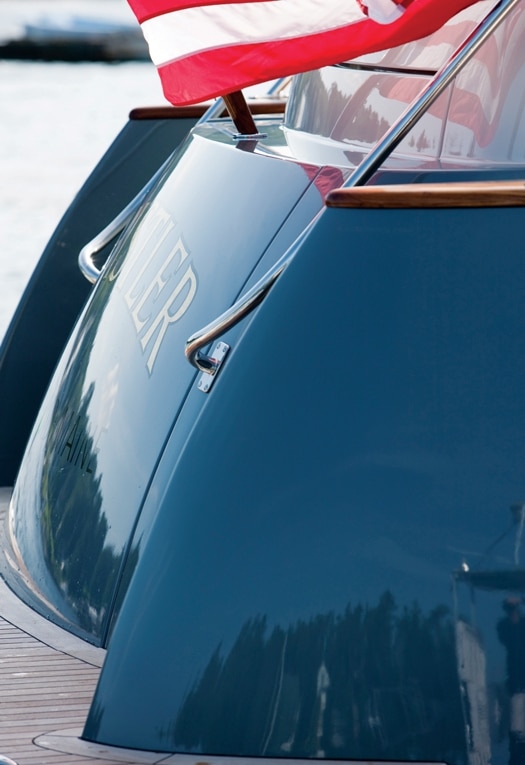
ytgsep17design525.jpg
The idea of building a custom yacht comes freighted with all manner of implication. To many people, a custom build speaks of opulence and grandeur, of over-the-top options that answer the question why? with a defiant because that’s how I wanted it.
Those are the eye-catching megayachts. But in many cases, custom builds really are not like that. For these yachtsmen, it’s more about knowing what you want, about having enough water in your wake to understand more clearly where your bow is pointed. It’s about enjoying a process where good people treat each other with respect and trust, and in so doing embark on an undertaking that’s nothing short of monumental in scale-even on modestly sized craft-and very personal. Think about it: Only you can have a boat built this way-your way.
So, hot-tub accessories and escargot utensils aside, we’d be foolish to say that money doesn’t enter into it. And we’re certainly not saying that a custom build is the least expensive way to get a great boat. After all, there are many boats for sale right now that can suit the needs of a wide variety of yachtsmen. Custom boats don’t always repay their first owners when it’s time to sell. But it’s not about that.
“It’s the process,” says Michael Peters of Michael Peters Yacht Design in Sarasota, Florida. “We have always told people that came and wanted to do a one-off project: ‘if you don’t love the process, don’t do it.’ There are too many boats for sale, just go buy one. Why would you take such a long route to do this? There’s no level of instant gratification at all. It’s a long time between the idea of doing it and the launch-three or four years sometimes, maybe longer. So you’ve got to love creating stuff.”
Just ask the owner of Whistler, a twin-jet express cruiser designed by C. Raymond Hunt Associates and built by Lyman-Morse Boatbuilding Co. in Thomaston, Maine.
“I enjoy the process of building things,” says Whistler’s owner. “I’m a painter and sculptor in my free time. So working with the details of building is not stressful-I mean it’s not stressful in a negative way-I enjoy that process. The fact that Lyman-Morse is just 15 minutes away makes it very easy. I would go up once a week. You get to know the crew and you work very closely on all the details. And I like that environment, seeing the meticulous work that everybody does, deciding on the details.” After all, that’s why everyone is there, to make sure everything is the way the owner wants it, down to the smallest element.
“The ideas oftentimes will be presented with the next phase, and the builders would say ‘You’ve got choices a, B, or c’ and ask me to pick one,” the owner says. “And sometimes I would make a decision and then a week later we would come back and they would say ‘We were looking at that, and we think maybe you ought to look at it differently.’ And we would make some changes. So they would often add their input, if they thought I made the wrong decision, and they would let me know.” The idea is that the build hews to the desires of the owner, but with a good builder, you get a firm hand of guidance along the way.
“Having a little bit of experience helps,” says J.B. Turner, president of Lyman-Morse Boatbuilding. “Because we ask thousands of questions. And if you don’t have anything to base it on, it’s more difficult for the owner. We’re going to ask all kinds of questions, and it gets pretty personal, too. By the time we’re finished building the boat together you know what side of the bed they sleep on, you know which hand they use, you know how they reach for their forks and knives… everything.” But the questions start long before even the first tool is touched. That’s where the designer comes in.
“There’s a lot of time spent one on one with the client to try to figure out and quantify exactly what it is that he wants to do,” says Peter Boyce, senior designer at C.R. Hunt Associates. “Some clients know exactly what they want to do and are very good at expressing themselves. [Whistler’s owner] had a very clear idea of what he needed and a reasonably clear idea of what kind of look he wanted. So it was a pretty straightforward process to get from a blank sheet of paper to a complete preliminary design.”
“There’s plenty of design and engineering that goes into these custom boats,” says Boyce. “We do all of the envelope-the hull, deck, and superstructure-everything is all modeled in 3-D and there’s a lot of hours in that. There’s a lot of 2-D CAD drawings as well: machinery and accommodations and hardware and laminates and structure.” But the design of the yacht and its engineering are shared with the builder.
“There’s a lot of scantling calculations and I would bet there’s probably somewhere between 2,000 and 2,500 hours of design and engineering work done here in this office,” says Boyce. “there is probably another couple thousand hours of design and engineering work done inhouse at Lyman-Morse, with all the shop drawings that they have to do for custom bits of hardware and systems-they do all the electrical schematics and plumbing schematics. So you’re probably looking at 4,000 or 4,500 man-hours of design and engineering in a project like this.” And that’s just the design. Nothing has been built yet-except a mockup that lets the owner get a sense of what the boat will be like.
Remember, on a custom build, there is no floor model to check out. The mockup, usually fashioned out of plywood and cardboard to the actual dimensions of the design, is a big part of a custom build. “Small, big, it doesn’t matter-you have to feel the space,” says Turner. “You can move a bulkhead in a mockup for about $40. You can move a bulkhead in a boat for about $400,000. We’ve had boats change dimensions dramatically because of mockups, which is why we don’t spend a lot of time on design before we do the mockup. We had a 74-footer we did; the mockup was done on a 67. The first thing the owner did, he walked through the pilothouse and down into the main salon and looked around and said ‘nope.’ There we go, make it bigger.”
“You can see the actual space and scale of things, right from the beginning,” says Whistler’s owner. “You do that before you even start building the boat. But we continued to do that in some of the cabinetry. We have maple, walnut, and mahogany as the basic theme and we switched them around, more than once, till it came out right.”

| | |
As the decisions get made, one by one, the build gets going and the yacht comes together. And the questions keep coming and the owner and designer monitor the build’s progress and stay in regular contact. To keep a project of this scope manageable, the owner, builder, and designer break it down into digestible parts. It’s easy to lose sight of the whole when you’re immersed in the details.
“It’s interesting because you think you know how it’s going to be, you think you can visualize it,” says Whistler’s owner. “But on launch day, it’s the first day that all the protective covering is taken off of all the woodwork and all the paneling and upholstery, and the lighting is all up and running. Because all you see is a little piece at a time as it’s going together and then it gets covered up with plastic or cardboard, so you don’t see the relationships of the colors and the shapes and everything. So when you see it that first time-and I think it’s even this way for the crew-it’s like Oh my God there it is. That’s what we’ve been doing. That launch day is like Christmastime. The package is unwrapped and there you go.”
“It’s a big moment when the boat hits the water,” says Boyce. “And up until then, as a designer, you don’t really know what the boat is going to weigh. We had a pretty good idea, but there’s always this sort of tense minute when they’re letting it out of the slings and you think Okay, how close is this going to float to where we put the waterline? And then there’s another moment when you fire it up and you leave the dock and you get out of the narrow part of the river, and you actually get up on plane and all of a sudden you’re going 32 knots, and then you’re going 34 knots, and then you’re going 37 knots.”
The relief of such performance is amplified when one thinks back on the work-sometimes years of it-leading up to the launch. “There is no prototype with a custom boat,” says Boyce. “So there’s always some level of uncertainty. And that’s where the owner relies on the designer and builder, and draws on their collective experience to create something new.”
“This is about relationships, and there is a whole lot of trust involved,” says Turner. “And without that trust the whole thing doesn’t work, and the whole project falls apart very quickly.”
“If you have a good design group and a good builder, they’re going to lead you down the right road so you end up with the boat you want,” says Turner. “If either one of those two legs is weak, you’re going to have a problem. It’s just not going to work. If you don’t have a good builder that can give you the right recommendations all the way along, or [you have] a naval architect who is out to lunch and his weights are all off and his hull form is wrong, then you’re going to be in trouble. If you’re able to answer the basic questions that we need to know as to how you use things and how you work around the boat, we’ll give you the boat you want and it will perform and work the way you want it to, but the team has to be strong.”
“Building a custom yacht has got to either be an individual dream or it’s got to fulfill a statement of individuality,” says yacht designer Peters, who often tries to dissuade potential one-off clients, though he’s not immune to the appeal of the idea. “I can tell you I’m in exactly the same category, because I’ve been drawing a boat for myself, and I’ve been drawing boats for myself my whole life.” For a certain type of yachtsman, the custom build is the ultimate expression of self, combining an individual’s experience and desires into a one-of-a-kind package.
But when asked if he would do it again, Whistler’s owner went in a new direction. “The million-dollar question is would you change anything? And I wouldn’t change anything,” he declares. “It’s a great boat, the performance is just what we were looking for, the systems are great. I’d certainly do it again, but I don’t plan on doing it any time soon.”
C. Raymond Hunt Associates, (505) 717-0600; www.crhunt.com**; Lyman-Morse Boatbuilding Co, (207) 354-6904;** www.lymanmorse.com**; Michael Peters Yacht Design, (941) 955-5460;** **www.mpyd.net**








